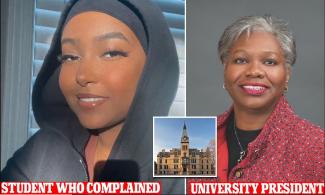
The 42-year-old Professor was let go from her position at the university in Saint Paul despite warning students ahead of time about the 14th-century imagery.
Hamline University, a private liberal arts school in St. Paul, Minnesota, U.S. has reportedly declined to renew the contract of a professor, Erika López Prater who showed her students medieval paintings depicting the Muslim Prophet Muhammad.
The 42-year-old Professor was let go from her position at the university in Saint Paul despite warning students ahead of time about the 14th-century imagery.
A new report from the New York Times indicates the professor was fired by Hamline University President Fayneese Miller for putting academic freedom over the respect of Muslim students.
Many practising Muslims do not believe in looking at pictures of Prophet Muhammad as they believe it may lead to worshipping an image.
Daily Mail reports that on October 6, 2022, the adjunct professor displayed the images during an online lecture. The incident gained traction after a student in attendance, Aram Wedatalla, president of the university’s Muslim Student Association (MSA), raised the issue with university administrators following a conversation with the professor.
As reported by Hamline University’s student newspaper The Oracle on December 6, a video recording of the lecture, alongside shared email correspondence between the professor and Wedatalla, indicated that the professor issued a two-minute content warning.
This warning was meant to allow students who were uncomfortable with viewing the images to exit the call or shut off the video component of the Google Meet room prior to proceeding with the Powerpoint slides featuring the images in question.
“I am showing you this image for a reason,” the professor said in the video, according to The Oracle. “And that is that there is this common thinking that Islam completely forbids, outright, any figurative depictions or any depictions of holy personages. While many Islamic cultures do strongly frown on this practice, I would like to remind you there is no one, monothetic Islamic culture.”
The first artwork was identified as “a 14th-century depiction of the Prophet receiving his first revelation from the archangel Gabriel” by Rashīd al-Dīn, and the second as the “Prophet with a veil and halo,” created by Mustafa ibn Vali in the 16th century.
The news of the professor’s dismissal was first reported by Christiane Gruber, a professor of Islamic art at the University of Michigan, in New Lines Magazine, a publication of the New Lines Institute nonprofit think tank. Gruber cites Hamline’s associate vice president of inclusive excellence, David Everett, saying “it was decided it was best that this faculty member was no longer part of the Hamline community.”
Hamline University did not respond to Hyperallergic’s repeated requests for comment, and Wedatalla could not be reached for comment. The news of the professor’s dismissal has yielded criticism from academics and literary activist groups such as PEN America and the Foundation for Individual Rights and Expression (FIRE), which denounced the incident as a violation of academic freedom.
Although there is no specific mention in the Quran, it’s broadly accepted that most Muslims do not create or intentionally view figurative imagery of Prophet Muhammad and other Islamic prophets per the belief that Allah is the sole creator of living forms, coupled with the notion that imagery is a portal to idol worship and polytheism.
According to the Hadiths, or detailed records of Muhammad’s life and teachings, those who paint pictures would be punished on the Day of Resurrection, and be challenged to “breathe life soul into what [they] have created.” However, the prohibition of figurative representation of the prophet, or humans in general, varies across sects and traditions.